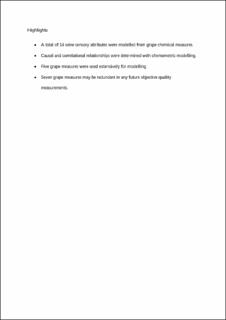Objective measures of grape quality: From Cabernet Sauvignon grape composition to wine sensory characteristics
Niimi, Jun; Tomic, Oliver; Næs, Tormod; Bastian, Susan E.P.; Jeffrey, David W.; Nicholson, Emily L.; Maffei, Suzanne M.; Boss, Paul K.
Peer reviewed, Journal article
Accepted version
Permanent lenke
https://hdl.handle.net/11250/2725031Utgivelsesdato
2020Metadata
Vis full innførselSamlinger
- Artikler / Articles [1449]
- Publikasjoner fra CRIStin [2518]
Sammendrag
In an investigation of objective measures that link grape composition to wine quality, this study sought to identify Cabernet Sauvignon grape parameters that predict the sensory properties of the corresponding wines. Eleven chemical measures comprising volatile and non-volatile compounds, enzyme activity plus standard industry harvest measurements were applied to grape samples obtained from different regions throughout South Eastern Australia over three vintages. Grapes underwent controlled vinification and the resulting wines evaluated with sensory descriptive analysis. The entire multi-vintage data sets were combined and modelled using a combination of partial least squares (PLS) and sequential and orthogonalised (SO) -PLS regression techniques. Optimal models were obtained with single sensory attributes rather than global modelling with the entire sensory profile. Five grape chemical measures, which in the main were harvest parameters, were used along with colour, total phenolics and tannin, targeted volatiles, and flavonols, and orthogonalised to model 14 sensory attributes of the Cabernet Sauvignon wines. The seven remaining measures were not used due to their poor ability to model wine sensory attributes, with enzyme activity and tannin by HPLC explaining the least. The study revealed new insights into the relationship between grape chemistry and wine sensory characters, which has implications for developing an objective measurement system for determining grape quality.
